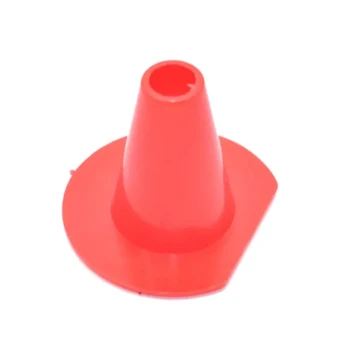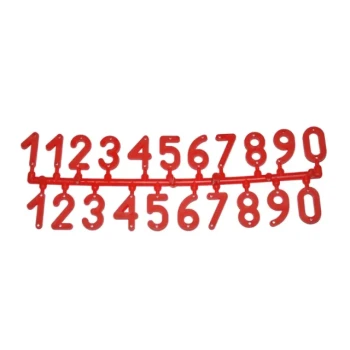At its core, a queen excluder is a simple but powerful tool for hive management. It is a perforated barrier, typically made of metal or plastic, with openings that are large enough for smaller worker bees to pass through but too small for the larger queen bee. By placing it between the hive's brood chamber and the honey supers, beekeepers can confine the queen to the lower sections of the hive, preventing her from laying eggs in the frames intended for honey storage.
A queen excluder is fundamentally a tool of separation. Its purpose is to create a distinct division between the queen's egg-laying domain and the workers' honey storage area, leading to more organized hives and a cleaner honey harvest.

The Core Principle: Separating Brood from Honey
The effectiveness of a queen excluder lies in a simple anatomical difference. The queen bee has a larger thorax than her worker bees, and the excluder's slots are precisely sized to exploit this.
How the Excluder Works
The excluder is placed directly on top of the uppermost brood box—the area designated for the queen to lay eggs and raise brood. The honey supers, which are boxes of frames for honey storage, are then placed on top of the excluder.
Worker bees can move freely through the slots to deposit nectar and build honeycomb in the supers. The queen, however, is physically blocked from ascending into this area.
The Impact on Hive Organization
This separation creates a highly organized hive structure with two distinct zones: a brood nest below and a honey pantry above.
This makes hive inspections more predictable. The beekeeper knows the queen and all eggs, larvae, and pupae will be located in the boxes below the excluder, simplifying tasks like checking the queen's health and brood pattern.
The Primary Benefit: A Cleaner Honey Harvest
The most significant advantage of using an excluder is that it ensures the honey supers remain brood-free.
When it comes time to harvest, every frame in the super contains only honey and wax. This eliminates the risk of mixing larvae or pupae into the extracted honey, resulting in a higher quality product and a much simpler, cleaner extraction process.
Understanding the Trade-offs and Debates
While effective, the queen excluder is a subject of debate among beekeepers. Its use is a management choice with potential downsides that must be considered.
The Risk of a "Honey Bound" Brood Nest
By confining the queen, you risk a situation where the workers backfill the brood chamber with nectar, leaving her with no empty cells to lay eggs. This is known as being honey-bound.
This congestion can severely limit the colony's growth and is a major trigger for swarming. A beekeeper using an excluder must be vigilant and ensure the queen always has adequate laying space.
The Argument Against Excluders
Some beekeepers argue that forcing workers through the narrow slots can damage their wings over time or slow their passage, potentially reducing the speed of honey production. This is often referred to as "Excluder Syndrome."
Furthermore, many "naturalistic" beekeepers believe a strong, well-managed colony doesn't require an excluder. A prolific queen will typically stay within the brood nest, surrounded by a natural "honey barrier" created by the workers, without the need for a physical one.
Advanced Applications Beyond Honey Production
For experienced beekeepers, the excluder is more than just a honey management tool. It enables a variety of advanced techniques.
Creating Two-Queen Hives
Excluders are essential for creating and managing two-queen colonies. By using excluders to separate two queens within a single, vertically stacked hive, a beekeeper can dramatically increase the population and potential honey output of that colony.
Specialized Production
The excluder is also used in niche beekeeping practices like queen rearing and the commercial production of royal jelly, where precise control over the queen's location is critical.
Deciding If a Queen Excluder Is Right for You
The decision to use a queen excluder depends entirely on your beekeeping goals and management style.
- If your primary focus is maximizing honey purity and simplifying extraction: Use an excluder to guarantee brood-free honey supers and make harvesting easier.
- If your primary focus is a less-intensive, naturalistic approach: You can forgo the excluder, but you must accept the possibility of a more disorganized hive and the need to sort brood frames from honey frames during harvest.
- If you are an advanced beekeeper exploring complex hive configurations: The excluder is an indispensable tool for controlling bee placement and behavior.
Ultimately, the queen excluder is a tool that offers control in exchange for increased management responsibility.
Summary Table:
| Aspect | Key Takeaway |
|---|---|
| Primary Function | Physically separates the queen from honey supers to prevent brood in honeycomb. |
| Main Benefit | Ensures a brood-free, cleaner honey harvest. |
| Key Consideration | Requires vigilant management to prevent a "honey-bound" brood nest and swarming. |
| Ideal For | Beekeepers focused on maximizing honey purity and advanced hive configurations. |
Ready to optimize your apiary's efficiency and honey yield?
At HONESTBEE, we supply commercial apiaries and beekeeping equipment distributors with the high-quality, durable tools they need to succeed—including premium queen excluders. Our wholesale-focused operations ensure you get the reliable equipment required for superior hive management and a pristine honey harvest.
Contact our expert team today to discuss your wholesale needs and discover how HONESTBEE can support your commercial beekeeping success.
Visual Guide

Related Products
- Professional Plastic Queen Excluder for Modern Beekeeping
- High Performance Plastic Queen Excluder for Beekeeping and Apiary Management
- Premium Wood Framed Metal Wire Queen Bee Excluder
- Metal Queen Bee Excluder for Beekeeping
- 8-Frame Electric Self-Reversing Honey Extractor Spinner for Commercial Honey Extraction Equipment
People Also Ask
- What is the primary function of a queen excluder in beekeeping? Control Hive Layout for Efficient Honey Harvesting
- How does a queen excluder work? Master Hive Management for Pure Honey Harvests
- What are the main advantages of using a queen excluder in beekeeping? Simplify Hive Management & Harvest
- What is the purpose of a queen excluder when adding a super? Streamline Your Honey Harvest
- How do queen excluders work in terms of spacing and bee movement? A Guide to Precision Hive Management



















